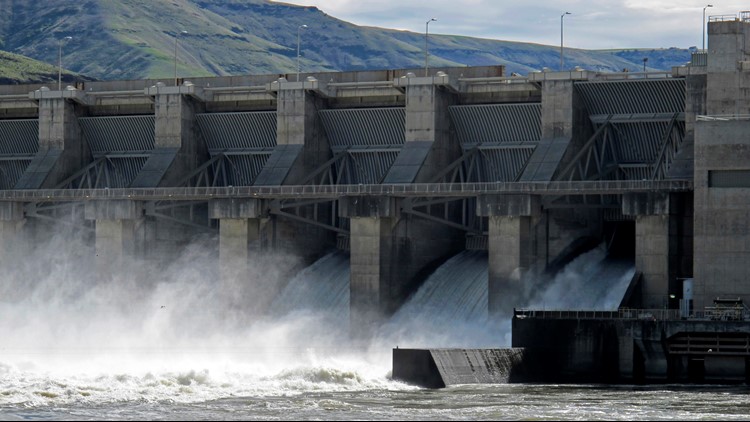BOISE, Idaho —
This story originally appeared in the Idaho Press.
When Treasure Valley summer temperatures start soaring into the 100s, is Idaho’s electrical grid vulnerable to blackouts?
Though hot weather can tax energy resources in the state, Idaho would not be vulnerable in the way that Texas was in February 2021 when a rare winter storm squeezed energy production there, said Benjamin Brandt, director of load serving operations for Idaho Power. Idaho has a more diverse set of energy sources than Texas, which is heavily dependent on natural gas, Brandt said.
Natural gas powers most power plants in Texas, according to reporting from the Texas Tribune. In February 2021, when a cold storm moved across the state, natural gas wells froze, hampering power generation and amounting to a loss of 34 gigawatts of power, Brandt said.
Texas is uniquely positioned in that its energy grid operates somewhat independently of the rest of the country and is managed by an entity known as the Electric Reliability Council of Texas, according to the Dallas Morning News. If the state had imported more energy when they needed it, it could have better addressed the energy shortage, Brandt said.
“Texas’s issue was that they weren’t going to get 34 gigawatts from anybody,” Brandt said.
On Sunday, ERCOT asked customers to reduce power usage due to higher-than-normal July temperatures driving up demand on the grid, and a lack of wind power generation, according to the Texas Tribune.
Idaho Power’s grid has several key differences with that of Texas’. First, hydropower is the largest energy source and provides reliability, Brandt said.
Second, Idaho Power officials have worked with public utilities commissions to build transmission lines that allow it to easily import and export energy from other areas in the northwest, he said. With the exception of last year’s heat dome event, areas such as Seattle and Portland generally experience peak energy demand in the winter, whereas Idaho’s demand peaks in the summer, Brandt said. Transmission lines allow utilities to send power where and when it’s needed, he said.
Lastly, Idaho Power’s energy resources include wind, solar, geothermal, and coal, he said.
“What got (Texas) into trouble was all the gas (generation) that they lost; all their solar and wind did not produce either because of the weather,” Brandt said. “They don’t have the hydro or the transmission diversity that we have that would give them the ability to ride through something like that a little bit better.”
That said, Idaho’s grid is not completely immune to challenges, Brandt said. Wind and solar power can be variable in the amount of energy generated and when it is generated, he said. This can be diversified by having different projects in locations from east to west that generate power at different times as the Earth rotates over the course of the day, he said.
The loss of transmission lines could affect Idaho’s ability to move energy where it is needed, and the company is working to make its system more resilient in times of extreme heat and as the area grows, he said. Oftentimes, that will require funding infrastructure such as transmission lines or storage capacity, he said.
“Investing now and being able to get those items permitted and constructed is really critical … meeting the demands and challenges of life that are coming to Idaho Power in the next 5 to 10 years, it takes a while to build stuff,” he said, adding that the company’s working relationship with the public utility commissions and other agencies helps needed projects move forward.
Idaho Power has made appeals to customers to conserve during peak hours, generally between 5 p.m. and 10 p.m., Brandt said. Those efforts reflect the company’s interest in conserving energy and helping customers conserve and save money, he said.
Brad Bowlin, a communications specialist with Idaho Power, said that one of the company’s largest conservation programs is its Irrigation Peak Rewards program. Irrigation systems are powered by electricity, and it is the most significant driver of local energy demand during summer, he said.
The program pays irrigators to not irrigate during hot, late afternoons, Brandt said. Customers save money from not using energy during that time, and the company can avoid having to build infrastructure to meet that level of demand, he said.
Two projects are in the works to help the company meet future demand and to help the company reach 100% renewable energy by 2045, Bowlin said via email. One project, the Boardman to Hemingway transmission line, will bring energy from a substation in eastern Oregon to Owyhee County, Idaho, and vice versa, according to the company’s website. A separate 120-megawatt battery storage project is expected to come online in 2023, and will help the company store energy until it is needed, including wind and solar energy, Bowlin said via email.
This story originally appeared in the Idaho Press. Read more at IdahoPress.com
Watch more Local News:
See the latest news from around the Treasure Valley and the Gem State in our YouTube playlist:



